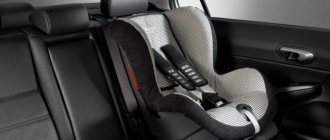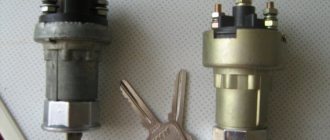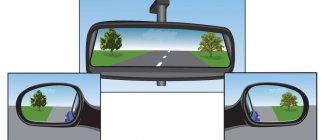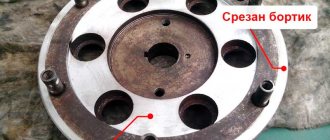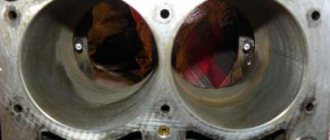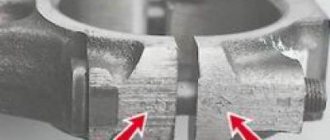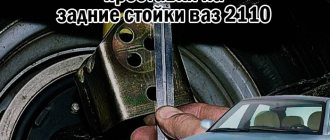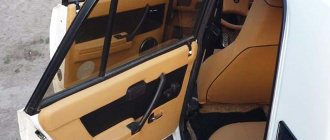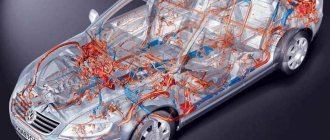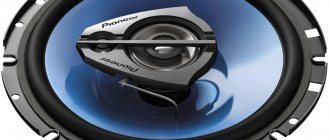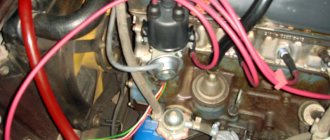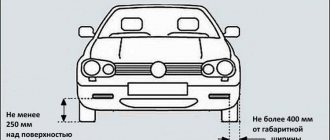Basic rules for installing a child seat
Since there are many companies involved in the production of car seats, the specifics of their installation can vary greatly.
But there are several general rules that must be followed when attaching any infant carriers:
- Before securing the car seat in the back seat, you need to extend the seat belt about a meter. This will simplify the further process.
- After placing the infant carrier, you should make sure that it is securely fastened with straps and does not slip or move around the cabin.
- In some cases, it is necessary to tighten the standard tape, since it periodically moves while driving. Sometimes the seat belt clip is included with the restraint system.
- A seat for a newborn up to six months can be placed exclusively in front of the passenger seat.
- When placing a seat in the front seat near the driver's seat, the front passenger airbag must be turned off.
- To avoid damaging your baby's delicate skin, use only soft pillows. In addition, it is recommended to attach soft pads under the belt buckle or use a terry towel.
When placing the infant carrier, make sure that it is securely fastened with straps.
Before leaving, you should check the position of the ventilation and air conditioning system openings. They must be adjusted so that the cold does not reach the child.
How to determine whether a child can be fastened with a regular seat belt?
Your child should sit upright in the passenger seat and lean against the back of the seat. His legs should hang down and reach the floor without forming a stooped body. Your child, while securely fastened with a seat belt, should not slide down under the belt, as the lumbar portion of the seat belt may move toward the child's abdomen if it is not properly secured. That is, the belt should ideally hold the child in one position.
Correct position of the child in the passenger seat.
BACK.
The back is straight and completely adjacent to the back of the seat.
LEGS.
The knees are moved further than the edge of the passenger seat. The legs hang freely from the chair and reach the floor.
Methods for attaching a child seat in a car (with instructions)
All instructions recommend installing a child car seat in the center of the rear seat so that the small passenger sits forward facing (this does not apply to infant products). The range of such accessories available for sale is quite extensive, so there are different ways to install them.
ISOFIX
A fairly common fixation system, which involves attaching the seat to the rear of the body using carabiners. High-strength stainless steel is used when assembling fasteners. This technology prevents damage to system elements and injury during a sudden stop. In addition, the ISOFIX method is convenient for parents to use, since to install the car seat, it is enough to insert it into the grooves until it stops.
However, some vehicle models do not have such a product. Therefore, car seats with Isofix cannot be used in every car.
Brief instructions for installing a chair with this technology are as follows:
- Find the mounting points in the form of plastic recesses with plugs (you need to remove them and hide them in the glove compartment).
- Insert the car seat elements into the corresponding grooves of the standard seats.
- Push the infant carrier forward until it clicks.
ISOFIX involves attaching the seat to the body with carabiners.
As an additional measure, you can throw the belt over the back and securely fasten it.
Standard seat belt
You can also secure the infant carrier at the rear using standard seat belts. In this case, the children's accessory must have special grooves. You need to insert straps into them and securely fix them in the desired position. The disadvantage of factory designs is a number of installation difficulties.
In addition, deviations in the geometry of the seat and car seat cannot be ruled out, which can cause inconvenience to all passengers.
Latch or Super Latch
The method is somewhat reminiscent of the Isofix system, but it uses a different type of belt. It was developed by craftsmen from the USA who wanted to create an effective and reliable method of protecting children in car seats from all kinds of injuries while in the car. In Russia, the technology has not become widespread.
A car seat with similar fasteners has a special belt with metal carabiners. They are located on both sides of the seat and are improved subtypes of the ISOFIX fastening.
The chair must be fixed according to the following instructions:
- Unfasten the straps on the sides.
- Place the chair on the side mount.
- Press down on it and tighten the straps.
- Throw the belt over the back.
The Latch system uses a different type of belt.
Support
As an alternative to a tape with a belt, you can use a special stand - a support. It rests firmly on the floor, preventing the structure from moving. This option is highly trusted by motorists, but its installation requires additional time and effort.
Anchor strap
It is a special technology that prevents any movement of the car seat during sudden braking. The anchor belt is fixed to special loops on the child seat and car interior. In most cases, the anchors are located behind the seat on the backrest or floor covering of the cab.
Despite a number of advantages, the anchor belt also has negative sides. The main disadvantage is the limitation on body weight.
It should not exceed 18 kg. If you deviate from this rule, the system will be ineffective.
Is the device suitable for a baby?
Manufacturers produce restraints designed for children of various ages, which are divided into groups according to the child’s weight. For infants, infant carriers (also called car cradles) of groups “0” (child’s weight up to 10 kg) and “0+” (child’s weight up to 13 kg) are suitable. That is, they are designed for children under the age of approximately one and a half years.
Such infant carriers have two main features: firstly, the child does not sit in them, but reclines, because being in a sitting position for a long time is harmful to the health of infants. The second feature is that they are installed in such a way that the child is positioned backwards, facing the rear window of the car. This is done so that in the event of sudden braking or a collision, the baby’s heavy (relative to body weight) head will be supported by the cradle bed or the back of the chair.
Mounting a booster on the back seat of a car
Every car has several potential safety zones where it is recommended to install child car seats. They were discovered during crash tests and are reflected in child accident statistics.
Among them is the rear seat behind the driver's seat. In this case, the likelihood of injury is minimized, especially in frontal collisions. The driver turns the steering wheel in such a way as to prevent an impact from his side.
Positioning the seat behind the driver's seat reduces the likelihood of injury.
It is also possible to place a booster in the central part of the rear seat. In this case, regardless of the direction the steering wheel is turned in an accident, the impact falls on the rear, which does not affect the small passenger in any way.
It is prohibited to transport children with the booster seat placed in front. When the airbags are turned off, the risk of injury becomes maximum, and even simple movement on a flat asphalt surface will cause great discomfort to the passenger.
Where should the baby seat be installed?
According to the rules of the road, children can be kept in a secured car seat in any seat. Therefore, there are no strict restrictions on the installation location of the accessory.
Front next to the driver
This option is convenient for both the child and the parents, provided that there is enough space in the front to comfortably place the infant carrier. Children will get a wide view from the street, and adults will be able to monitor their condition and behavior. If you stop in a traffic jam, you will have the opportunity to feed the baby or play with him. But according to statistics, the risk of a fatal outcome in a collision is 2.4 - 3.2 times higher than when placing the seat in the rear.
The seating option in front next to the driver is convenient for a child.
In the case of rapid braking and light impacts, the position of the cradle with its back to the direction of movement is quite safe - the likelihood of injury to the spine of a newborn is minimal.
If we are talking about children over 3 years old, it is not recommended to place a child seat in front.
The child's back will not move, so it will be at risk.
Right back seat
The seat in the right corner is among the most efficient and secure in left-hand drive vehicles. It is located in the opposite direction from oncoming cars, therefore it is maximally protected from damage in the event of a traffic accident.
However, the driver will not be able to see where the child is and how he is feeling in the rearview mirror. To solve the problem, you will need to buy another mirror.
Behind the driver in the back
Among the negative aspects of landing from behind, there is the danger of placing it close to the oncoming lane and roadway. But as statistics say, this is the safest zone, because in the event of an accident, the driver turns the steering wheel all the way in order to protect himself from impact.
The area behind the driver in the rear is the safest.
Back in the middle
If your car's cabin design has enough space to accommodate a car seat in the middle of the rear seat, use it. The safety of center mounting is due to the fact that, regardless of the position of the steering column and the direction of travel, in the event of a rear collision there is plenty of space to prevent injury. In addition, children will be protected from a sudden blow from the pillow. The risk of damage only arises in the event of a direct frontal collision.
Helpful tips for installing a child seat
There are a number of tips that will help in organizing safe placement in the car:
- Before seating children, you should make sure that the infant carrier is properly secured. The fastening elements must be reliable and the belts must be in full working order. The presence of scratches and defects is not allowed, since in such places the elements of the safety system often weaken and break during an accident.
- The child should be secured with belts so that he does not move, but is in a comfortable position. Fasteners should be tightened tightly.
- It is necessary to take care of reliable protection of the little passenger's head.
The instructions for installing a car seat look simple; the main thing is to follow the general rules and recommendations of car seat manufacturers.
Buckle up your child.
Remember, dear motorists, that the straps of a child seat must fit tightly enough to the child’s body. Only in this way will the child be reliably protected in the event of an accident. If the belts holding the child in the child car seat are loose, they will not be able to reliably hold and protect your child in the event of a sudden stop or an accident.
Here's what you should pay attention to first:
HEAD.
Please make sure there is enough free space between the top of the child's head and the top of the child car seat. Remember that all chairs differ depending on their type of design, brand and price category. To find out the exact distance that should be between the child’s head and the upper edge of the seat, first read the instructions for the car seat, where such data should be indicated.
SHOULDERS.
Also make sure the shoulder straps fit securely around your child's shoulders. In order to check the level of fit of the straps to the child, insert your finger under the strap in the area of the collarbone and pull your finger up (outward). If, by raising your finger up, you can pinch the strap of the car seat with your index finger and thumb, this will mean that the belt (strap) needs to be tightened further, since it does not securely hold the child in the seat.
BREAST. Next, make sure that your baby's chest is also securely supported by the seat belts (straps).
SMALL OF THE BACK. Also make sure that the lower straps of the child car seat securely support your child's lower back and hips.
